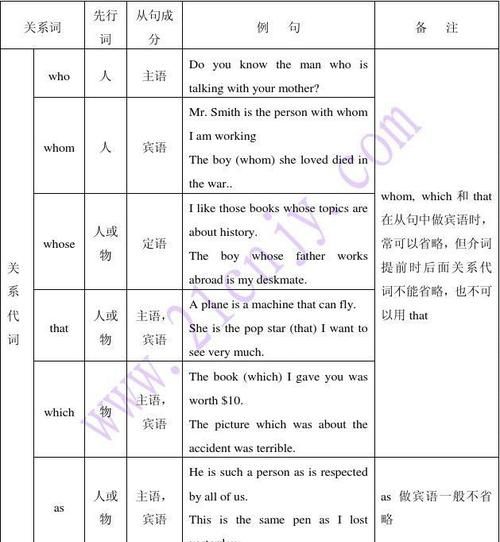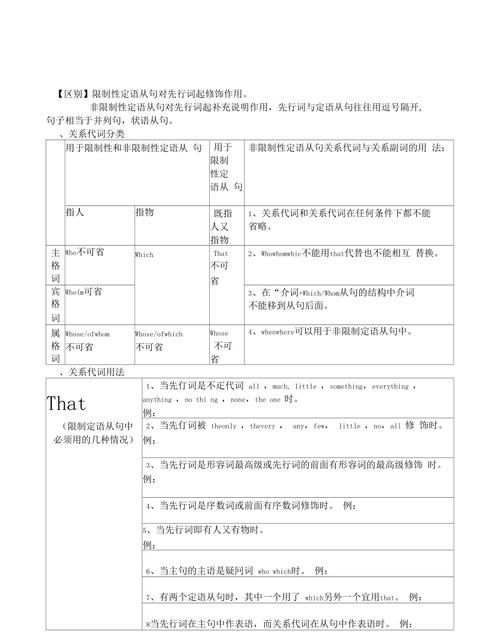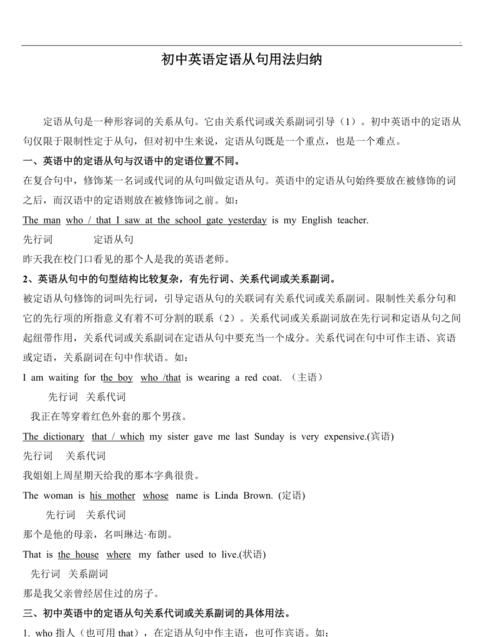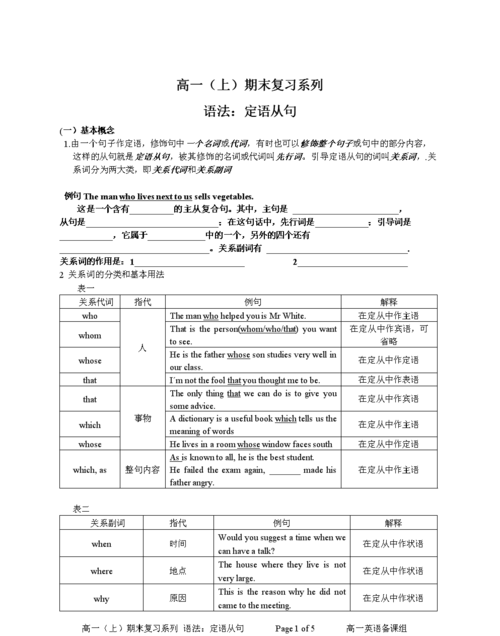本文目录
定语从句that的用法总结
老师叮咛:无论学习什么,必须先搞定定义,明白我们要学习的是什么。下面有关定语从句的内容非常重要,经过了全网首席高考英语名师李辉老师团队高度认真地整理校对、无错、可信!可供全国各省高中生打印、学习、背诵!
辉哥说:学任何东西先要把一些概念说清楚—— 正名的过程名不正则言不顺做任何一门学问,要知道这里头的概念说的是什么意思——正名
一、定语从句的概念
在复合句中,修饰某一名词或代词的从句叫定语从句。被修饰的名词或代词叫先行词,定语从句
一般放在先行词的后面。
二、定语从句的关系词
引导定语从句的关系词有关系代词和关系副词,常见的关系代词包括 that, which, who(宾格
whom,所有格whose)等,关系副词包括where, when, why 等。关系代词和关系副词放在先行
词及定语从句之间起连接作用,同时又作定语从句的重要成分。
三、定语从句的分类
根据定语从句与先行词的关系,定语从句可以分为限制性定语从句及非限制性定语从句。限制性
定语从句紧跟先行词,主句与从句不用逗号分开,从句不可省去,非限制性定语从句主句与从句之间
有逗号分开,起补充说明作用,如省去,意思仍完整。
四、关系代词的用法
1. that 既可以用于指人,也可以用于指物。在从句中作主语或宾语,作主语时不可省略,作宾语
可省略。
例如:Mary likes music that is quiet and gentle.
玛丽喜欢轻柔的音乐。(that 作主语)
The coat (that) I put on the desk is blue.
我放在桌子上的那件外套是蓝色的。(that 作宾语)
2.which 用于指物,在句中作主语或宾语,作主语不可省略,作宾语可省略。
例如:The building which stands near the train station is a supermarket.
位于火车站附近的那座大楼是一家超市。(作主语)
The film (which) we saw last night was wonderful.
我们昨天晚上看的那部电影很好看。
3.who, whom 用于指人, who 用作主语, whom 用作宾语。在口语中,有时可用who代替whom,
也可省略。
例如:The girl who often helps me with my English is from England.
经常在英语方面帮助我的那个女孩是英国人。(作主语)
Who is the teacher (whom) Li Ming is talking to?
正在与李明谈话的老师是谁?(作宾语)
注意:
(1)当定语从句中含有介词,介词放在句末时,who / that / which 可省略,但介词在关系代
词前时,只能用“ 介词 + which / whom ”结构。
例如:This is the house in which we lived last year.
这是我们去年居住的房子。
Please tell me from whom you borrowed the English novel.
请告诉我你从谁那借的这本英文小说。
(2)含有介词的固定动词词组中,介词不可前置,只能放在原来的位置上。
例如:This is the person whom you are looking for.
这就是你要找的那个人。
(3)that 作介词的宾语时,介词不能放它的前面,只能放在从句中动词的后面。
例如:The city that she lives in is very far away.
她居住的城市非常远。
(4)关系词只能用that 的情况:
a. 先行词被序数词或形容词最高级所修饰,或本身是序数词、基数词、形容词最高级时,只能
用that,而不用which。
例如:He was the first person that passed the exam.
他是第一个通过考试的人。
b.被修饰的先行词为all, any, much, many, everything, anything, none, the one 等不
定代词时,只能用that,而不用which。
例如:Is there anything that you want to buy in the shop?
你在商店里有什么东西要买吗?
c.先行词被the only, the very, the same, the last, little, few 等词修饰时,只能用that,而不用which。
例如:This is the same bike that I lost.
这就是我丢的那辆自行车。
d. 先行词里同时含有人或物时,只能用that,而不用which。
例如:I can remember well the persons and some pictures that I saw in the room.
我能清楚记得我在那个房间所见到的人和一些照片。
e.以who 或which 引导的特殊疑问句,为避免重复,只能用that。
例如:Who is the girl that is crying?
正在哭泣的那个女孩是谁?
f.主句是there be 结构,修饰主语的定语从句用that,而不用which。
例如:There is a book on the desk that belongs to Tom.
桌子上那本书是汤姆的。
(5)关系词只能用which,而不用that 的情况:
a.先行词为that,those 时,用which,而不用that。
例如:What’s that which is under the desk?
在桌子底下的那些东西是什么?
b.关系代词前有介词时,一般用which,而不用that。
例如:This is the room in which he lives.
这是他居住的房间。
c.引导非限制性定语从句,用which,而不用that。
例如:Tom came back,which made us happy.
汤姆回来了,这使我们很高兴。
五、关系副词的用法
(1)when 指时间,其先行词表示时间,在句中作时间状语。
例如:This was the time when he arrived.
这是他到达的时间。
(2)where 指地点,其先行词表示地点,在句中作地点状语。
例如:This is place where he works.
这是他工作的地点。a
(3)why 指原因,其先行词是原因,起原因状语作用。
例如:Nobody knows the reason why he is often late for school.
没人知道他为什么上学总迟到。
例题:
单项填空。
1. -Do you know the man ______is talking with your father?
-Yes,he ' s our headmaster.
A. he B. who C. which D. whom
2. Is this the river _____I can swim?
A. which B. in which C. that D. the one
3. This is the best hotel in the city _____I know.
A. where B. which C. that D. it
4. Can you lend me the dictionary ______the other day?
A. that you bought B. you bought it
C. that you bought it D. which you bought it
5. Anyone ______with what I said may put up you hands.
A. which agrees B. who agree C. who agrees D. which agree
6. My watch is not the only thing ______ is missing.
A. that B. it C. which D.who
7. The man ______coat is black is waiting at the gate.
A. who's B. whose C. that D.of which.
8. The girl ______ is reading under the tree _____my sister.
A. which; is B. whom; was C. who; is D. who; was
9. I love places ______the people are really friendly.
A. that B. which C. where D. who
10. The world ______ is made up of matter.
A. in that we live B. on which we live
C. where we live in D. we live in
参考答案:1-5BBCAC 6-10 ABCCC
(第十题解析:首先这句话的主句是完整的,且被修饰的名词“The world”在句子中充当成分,因而这个句子是定语从句,所以排除AB;又因为CD中的从句完整,所以被修饰词跟从句之间应该有一个关系副词,故第十题选C。)
(该资料来源于网络)

定语从句的用法归纳总结
一. 定义: 定语由一个句子来充当,那么这个句子就叫做定语从句。
eg: 其中划线部分为定语从句。
二. 分类: 分为限制性定语从句和非限制性定语从句,还有间隔性定语从句。 (限制性定语从句)
(非限制性定语从句)
( 间隔性定语从句)
注:定语从句和非限制性定语从句的区别
限制性定语从句无逗号隔开、不可缺少、起修饰限制作用;而非限制性定语从句有逗号隔开、可有可无、起补充说明作用。
三. 构成: 定语从句有先行词、引导词和从句构成。
先行词是定语从句所修饰限制的名词或代词。
引导词是用来引导定语从句的关系代词或关系副词。
eg: The old town has narrow streets and small houses that are built close to each other. 此句中先行词为:narrow streets and small houses, 引导词为:that, 定语从句为:that are built close to each other
四.基本原则
定语从句中不能出现与先行词在意义上相一致的词 与book指同一物,所以要去掉。)
五.定语从句中常见考点:
考点一.关系代词和关系副词的辨别
1. 关系代词that(人、物),which(物)、who(m)(人)、whose(某人的,某物的)、as
2. 关系副词when(表时间)、where(表地点)、why(表原因)
注:关系副词可变为“介词+关系代词”结构(即:关系副词=介词+关系代词)。
eg:This is the mountain village where(=in which)I stayed last month.
3. 怎样选择正确的关系代词或关系副词 方法一:找出先行词和定语从句中动词,看定从中动词与先行词能否构成习惯搭配。能,用关系代词;不能,用关系副词.
Eg.I will never forget the day定从中动词spent 与先行词
the day 构成spent the day ,所以用关系代词that或which或省略)
系代词。如不缺少,定语从句所表达意思相对完整,用关系副词。
eg:①.This is the factory ____ made cars . (缺少主语,所以用关系代词that 或which,作主语不能省略)
②.This is the reason _______ he was late for school.(定语从句he was late for school 表
达意思相对完整,所以用关系副词why 或介词+关系代词for which) 注意:当先行词为case、position、point、situation、society、activity等抽象意义的名词时,常用关系副词where引导定语从句.
eg:He got himself into a dangerous situation where he may lose control of the plane .
考点二. 定从中that 与which的区别
1. 关系代词只用that的情况。
(1)当先行词为不定代词(all、much、little、few、some、any、none、one、something、anything、everything等)或先行词被不定形容词(all、many、some、few、little等)修饰时。 that you want to say for yourself?
(2)当先行词既有人又有物时。 that you are talking about.
(3)当先行词含有序数词或最高级时。
eg: ① will go to Beijing.
②(4)当先行词被only、very、next、last等修饰时。
that I’m looking for.
(5)在who或which引导的特殊疑问句中。 that you lost?
(6)当关系代词在定语从句中作表语时。 that it used to be.
2.关系代词只用which的情况。
(1)引导非限制性定语从句时。
eg:He turned to be a very successful man,(2)在“介词+关系代词”结构中,关系代词只用which。
eg:This is the question they have so much discussion in the past few weeks.
(3)当关系代词后有插入成分时。
eg: Mary was much kinder to Jack than she was to the others, which, of course, made all the others upset.
3.指人时,关系代词只用who(m)的情况。
(1)引导非限制性定语从句时。 (2)当“介词+关系代词(宾格形式)”结构引导定语从句时。 (3)当关系代词后有插入成分时。
eg:This is my friend who,I think,is the best in our class. .
(4)在There be句型结构中,先行词指人时。
eg:There is a young lady who asks for you.
考点三:as的用法及as与which的区别
1. as引导的定语从句
(1)as常用于固定搭配中:the same. . . as,such…as,as/so…as
eg:①比较:Zhengzhou is such a wonderful city that everyone likes to visit it.
注意:第一句是定语从句,所以定从中没有出现与先行词city 意义上一致的词,第二句是状语从句,that 后应为完整句子,所以it 不能省略。
②同样的但不是同一辆)
比较:Today he wears the same coat that he did yesterday .(同一件衣服)
(2)as常用于固定句型中:as we all / everyboby know(s), ,as is often the case,as we expect等。
eg:As we all know,Zhengzhou is an attractive city.
2.在非限制性定语从句中,as与which的'区别
⑴指代整句话内容时,as可位于主句前面、中间或后面;而which一般位于主句后。另外,which还可指代一个名词或一个短语。
eg①: As we all know,Tom is a good boy.
②:China,which was founded in 1949,is becoming more and more powerful.
③:She doesn't think she is wrong,which makes her teacher angry.(which指代上文整个句子)
⑵.aswhich没有,
eg: ①He succeeded this time,as had been expected.
②She has made great progress,which makes her parents very happy.
③As we all know,knowledge changes life.
考点四. 定从中所属关系的表达
whose引导定语从句时必须和名词放在一起。whose+n(s)
=the+n(s)+of which/whom
=of +which/whom+the+n(s)
考点五.定从中动词形式与先行词的一致
eg: ① ②
③
考点六. the way作先行词引导定从时,关系词可用in which/that/省略。
eg:I don’t like the way that/in which/省略he spoke to me.
考点七. 介词+关系代词
在这种结构中,关系代词表示人,只能用whom ;关系代词表示物,只能用which 。
*怎样选择正确的介词
1.根据定语从句中谓语动词的习惯搭配来决定。如:
① This is the pen on which I spent 10 yuan. (spend money on sth.为固定搭配)
② This is the pen for which I paid 10 yuan. (pay money for sth.为固定搭配)
2.根据先行词的搭配习惯来决定。如:
① I remember the day on which I graduated from high school.
(强调在具体某一天要用介词on)
② I remember the days during which I lived in Russia.
(强调在某几天时间内要用介词during)
③ I remember the month in which I got along with Tom(在month前介词要用in)
3. 根据从句中动词与先行词的逻辑关系。
Is that the newspaper for which you often write articles?
(write ...for the article)
4. 根据从句中形容词的习惯搭配。
①The secretary with whom the boss is not happy will be fired for her carelessness .
( be happy with "对表示满意") 老板对其不满意的那个秘书将由于她粗心而被解雇。
②He is a learned man with whom we are familiar .
( be familiar with 对...熟悉)他是一位我们熟悉的有学识的人。
5. 有些“动词+介词”的固定词组不可拆开用
常见的动词词组有:look for,look after, care for,send for,hear of,hear from, deal with,
get through,pay attention to等。 Eg .This is the watch (which/that) I am looking for.这是我正在找的手表。 This is the watch for which I am looking.(错误)
6. “不定代词both,some,any,many,(a)few,none,neither等 +of whom 或of which,表示整体与部分的关系或所属关系
eg: ①(很多苹果中有一些是红色)
比较:I have many apples and some of them are bad .
②比较:He has three children but none of them is kind to him .
7.“介词+which+to do”作定语的情况
介词+which+to do作定语相当于介词+which引导定语从句。其中定语从句主语与主句主语一致,且从句含有情态动词。
eg:①Frank’s dream was to have a shop in which to produce the workings of his own hands.
(=Frank’s dream was to have a shop in which he could produce the workings of his own
hands.)
②He has no house in which to live.(=He has no house in which he can live.)
8.“介词+where”引导的定语从句的情况
有时候,我们可以见到“介词+where”引导定语从句的情况。此时,where代替的是表示地点的介词短语。
eg:You can look out of the window,from where you get a good view.(其中where=out of the
window)
考点八:定从句与短语的转化
1. The girl (who is )dancing now just returned from Beijing.正在跳舞的女孩刚从北京回来
2. I love the stories (which were) written by Mary .我喜欢玛丽写的故事。

定语从句的用法归纳
定语从句归纳及用法 1
I 关系代词引导的定语从句
关系代词所代替的先行词是人或物的名词或代词,并在句中充当主语、宾语、定语等成分,英语定语从句知识和用法概述。关系代词在定语从句中作主语时,从句谓语动词的人称和数要和先行词保持一致。
1)who, whom, that
这些词代替的先行词是人的名词或代词,在从句中作主语和宾语。例如:
Is he the man who/that wants to see you? 他就是你想见的人吗?(who/that在从句中作主语)
He is the man whom/ that I saw yesterday. 他就是我昨天见的那个人。(whom/that在从句中作宾语)
2) whose 用来指人或物,(只用作定语, 若指物,它还可以同of which互换)。例如:
They rushed over to help the man whose car had broken down. 那人车坏了,大家都跑过去帮忙。
Please pass me the book whose (of which) cover is green. 请递给我那本绿皮的书。
3)which, that所代替的先行词是事物的名词或代词,在从句中可作主语、宾语等。例如:
A prosperity which / that had never been seen before appears in the countryside.
农村出现了前所未有的繁荣。(which / that在句中作宾语)
The package (which / that)you are carrying is about to come unwrapped. 你拿的包快散了。(which / that在句中作宾语)
II. 关系副词引导的定语从句
关系副词可代替的先行词是时间、地点或理由的名词,在从句中作状语。
1)关系副词when, where, why的含义相当于"介词+ which"结构,因此常常和"介词+ which"结构交替使用。例如:
There are occasions when (on which) one must yield. 任何人都有不得不屈服的时候。
Beijing is the place where(in which) I was born. 北京是我的出生地。
Is this the reason why (for which) he refused our offer? 这就是他拒绝我们帮助他的理由吗?
2)that代替关系副词,可以用于表示时间、地点、方式、理由的名词后取代when, where, why和"介词+ which"引导的定语从句,在口语中that常被省略。例如:
His father died the year (that / when / in which) he was born. 他父亲在他出生那年逝世了。
He is unlikely to find the place (that / where / in which) he lived forty years ago. 他不大可能找到他四十年前居住过的地方。
III.判断关系代词与关系副词
方法一: 用关系代词,还是关系副词完全取决于从句中的谓语动词。及物动词后面无宾语,就必须要求用关系代词;而不及物动词则要求用关系副词。例如:
This is the mountain village where I stayed last year. 这是我去年呆过的山村。
I'll never forget the days when I worked together with you.我永远不会忘记与你共事的日子。
判断改错:
(错) This is the mountain village where I visited last year.
(错) I will never forget the days when I spent in the countryside.
(对) This is the mountain village (which) I visited last year.
(对) I'll never forget the days (which) I spent in the countryside.
习惯上总把表地点或时间的名词与关系副词 where, when联系在一起。此两题错在关系词的误用上。
方法二: 准确判断先行词在定语从句中的成分(主、谓、宾、定、状),也能正确选择出关系代词/关系副词。
例1. Is this museum ___ you visited a few days age?
A. where B. that C. on which D. the one
例2. Is this the museum ____ the exhibition was held.
A. where B. that C. on which D. the one
答案:例1 D,例2 A
例1变为肯定句: This museum is ___ you visited a few days ago.
例2变为肯定句: This is the museum ___ the exhibition was held.
在句1中,所缺部分为宾语,而where, that, on which都不能起到宾语的作用,只有the one既做了主句的表语,又可做从句的宾语,可以省略关系代词,所以应选D,英语语法《英语定语从句知识和用法概述》。
而句2中, 主、谓、宾俱全,从句部分为句子的状语表地点,既可用副词where,又因 in the museum词组,可用介词in + which 引导地点状语。而此题中,介词on 用的不对,所以选A。
关系词的选择依据在从句中所做的成分,先行词在从句中做主、定、宾语时,选择关系代词(who, whom, that, which, whose); 先行词在从句中做状语时,应选择关系副词 ( where 地点状语,when 时间状语,why 原因状语) 。
IV. 限制性和非限制性定语从句
1) 定语从句有限制性和非限制性两种。限制性定语从句是先行词不可缺少的部分,去掉它主句意思往往不明确;非限制性定语从句是先行词的附加说明,去掉了也不会影响主句的意思,它与主句之间通常用逗号分开。例如:
This is the house which we bought last month. 这是我们上个月买的那幢房子。(限制性)
The house, which we bought last month, is very nice.这幢房子很漂亮,是我们上个月买的。(非限制性)
2) 当先行词是专有名词或物主代词和指示代词所修饰时,其后的定语从句通常是非限制性的。例如:
Charles Smith, who was my former teacher, retired last year. 查理?史密斯去年退休了,他曾经是我的老师。
My house, which I bought last year, has got a lovely garden. 我去年买的的那幢房子带着个漂亮的花园。
This novel, which I have read three times, is very touching. 这本小说很动人,我已经读了三遍。
3) 非限制性定语从句还能将整个主句作为先行词, 对其进行修饰, 这时从句谓语动词要用第三人称单数。例如:
He seems not to have grasped what I meant, which greatly upsets me. 他似乎没抓住我的意思,这使我心烦。
Liquid water changes to vapor, which is called evaporation. 液态水变为蒸汽,这就叫做蒸发。
说明:关系代词that和关系副词why不能引导非限制性定语从句。
V. 介词+关系词
1)介词后面的关系词不能省略。
2)that前不能有介词。
3)某些在从句中充当时间,地点或原因状语的'"介词+关系词"结构可以同关系副词when 和where 互换。例如:
This is the house in which I lived two years ago. 这是我两年前住过的房子。
This is the house where I lived two years ago.
Do you remember the day on which you joined our club? 还记得你加入我们俱乐部的那一天吗?
Do you remember the day when you joined our club?
VI. as, which 非限定性定语从句
由as, which 引导的非限定性定语从句,as和which可代整个主句,相当于and this或and that。As一般放在句首,which在句中。例如:
As we know, smoking is harmful to one's health. 如我们所知,吸烟有害健康。
The sun heats the earth, which is very important to us. 太阳使地球暖起来,这对我们人类很重要。
典型例题
1)Alice received an invitation from her boss, ___came as a surprise.
A. it B. that C. which D. he
答案C. 此为非限定性从句,不能用 that修饰,而用which.,it 和he 都使后
句成为句子,两个独立的句子不能单以逗号连接。况且选he句意不通。
2)The weather turned out to be very good, ___ was more than we could expect.
A. what B. which C. that D. it
答案B。which可代替句子,用于非限定性定语从句,而what不可。That 不能用于非限定性定语从句,it不为连词,使由逗号连接的两个句子并在一起在英语语法上行不通。
3)It rained hard yesterday, ____ prevented me from going to the park..
A. that B. which C. as D. it
答案B. as 和which在引导非限制性定语从句时,这两个关系代词都指主句所表达的整个意思,且在定语从句中都可以作主语和宾语。但不同之处主要有两点:
(1)as 引导的定语从句可置于句首,而which不可。
(2) as 代表前面的整个主句并在从句中作主语时,从句中的谓语必须是系动词;若为行为动词,则从句中的关系代词只能用which.。在本题中,prevent由于是行为动词,所以正确选项应为B。
as 的用法
例1. the same…as;such…as 中的as 是一种固定结构, 和……一样……。例如:
I have got into the same trouble as he (has). 我碰到了跟他一样的麻烦。
例2. as可引导非限制性从句,常带有'正如'。例如:
As we know, smoking is harmful to one's health. 如我们所知,吸烟有害健康。
As is known, smoking is harmful to one's health.
As是关系代词。例1中的as作know的宾语;例2中,它充当从句的主语,谓语动词know要用被动式。
VII. 先行词和关系词二合一
1) Whoever spits in public will be punished here. (Whoever 可以用 anyone who 代替)
定语从句归纳及用法 2
一、定语从句的识别
1、结构识别:名词+连接词+句子
【例句】Kevin gave us a wonderful training course, which left us a deep impression.
【解析】这个句子的前身应该是这样的:Kevin gave us a wonderful training course. It left us a deep impression. it就是指代前面这个句子,这样两个句子就有了共有的名词,连接两个具有共同名词的句子是定语从句的作用,就可以用which代替it,这样就有了示例中的非限定性定语从句。
2、常用连接词:
关系代词:who, whom, which, that, as, whose
关系连词:when, where, why, how
介词+关系代词:as和that以及who一般不能接到介词后引导句子
二、定语从句的处理方法
1、按照定语的处理方法将定语从句前置,这种处理方式适用于比较短的和起修饰限定作用的定语从句。
2、在考研中大多数的定语从句起的作用是连接句子,因此我们通常把定语从句从整个句子中独立拆分出来单独成为一个句子,这种处理方法的关键是找到连接词,拆分点就是连接词。
对于“介词+连接词”引导的定语从句,拆分点就在介词处。
【例句】There is something by virtue of which man is man.
【译文】存在一种特性,人之所以为人就是由于这种特性。
【解析】这句话其实是由以下两句话变来的:
1)There is something.
2)Man is man by virtue of this thing.这两句话中有共有的名词something和this thing,用which替换掉this thing再把of which提前,得到:There is something of which man is man by virtue
三、例句分析
【例句】Such large, impersonal manipulation of capital and industry greatly increased the numbers and importance of shareholders as a class, an element in national life representing irresponsible wealth detached from the land and the duties of the landowners; and almost equally detached from the responsible management of business.
【译文】对资本和企业的这种大规模的非个人操纵大大增加了股东作为一个阶级的数量和重要性。这个阶层作为国计民生的一部分,代表了非个人责任的财富与土地及土地所有者应尽义务的分离,而且也几乎与责任管理相分离。
【解析】句子的主干为:Such large, impersonal manipulation of capital and industry greatly increased…shareholders as a class, (which was) an element…这句话的难点还在于其主语和宾语都有较长的短语和of结构限定,并且分句是由两个and相连的3个部分组成的。
分句an element…landowners又带有两个定语从句,一个是(which was)representing…,另一个是(which was)detached…。可见,定语从句的难点在于经常省略“引导词+be”的结构,从而在理解上容易和分词结构相混淆。实际上定语从句并不符合汉语的使用习惯。所以翻译时遇上定语从句,一定不要机械地按照原来的顺序生搬硬套。像这样分句较长的情况,把主句和分句拆为两句是比较好的方法。所以这里从“这个阶层”开始另起一句。
定语从句归纳及用法 3
定语从句在初中英语中的重要性主要体现在完形、阅读和写作中,因此,能否较好的掌握定语从句直接关系到你英语成绩的拔高。其实,定语从句并不难.
一. 定语从句的概念
在复合句中,修饰某一名词或代词的从句叫定语从句。被修饰的名词或代词叫先行词,引导定语从句的词叫关系词,定语从句一般放在先行词的后面。
二. 引导定语从句的关系词
引导定语从句的关系词有关系代词和关系副词,常见的关系代词包括that, which, who(宾格whom,所有格whose)等,关系副词包括where, when, why等。关系代词和关系副词放在先行词及定语从句之间起连接作用,同时又作定语从句的重要成分。
三. 定语从句的分类
根据定语从句与先行词的关系,定语从句可分为限制性定语从句及非限制性定语从句。限制性定语从句紧跟先行词,主句与从句不用逗号分开,从句不可省去。非限制性定语从句与主句之间有逗号分开,起补充说明作用,如省去,意思仍完整。
四. 关系代词的用法
1. that 既可以用于指人,也可以用于指物。在从句中作主语、宾语或表语。作主语时不可省略,作宾语可省略。例如:
Mary likes music that is quiet and gentle.
玛丽喜欢轻柔的音乐。(that作主语)
The coat (that) I put on the desk is blue.
我放在桌子上的那件外套是蓝色的。(that作宾语)
2.which用于指物,在句中作主语、宾语或表语。作主语不可省略,作宾语可省略。例如:
The building which stands near the train station is a supermarket.
位于火车站附近的那座大楼是一家超市。(作主语)
The film (which) we saw last night was wonderful.
我们昨天晚上看的那部电影很好看。(作宾语)
3.who, whom用于指人,who 用作主语,whom用作宾语。在口语中,有时可用who代替whom。who和whom作宾语时也可省略。例如:
The girl who often helps me with my English is from England.
经常在英语方面帮助我的那个女孩是英国人。(作主语)
Who is the teacher (whom) Li Ming is talking to?
正在与李明谈话的老师是谁?(作宾语)
注意:
(1)当定语从句中含有介词,介词放在句末时,who,whom,that, which可省略,但介词在关系代词前时,只能用介词+which/whom结构。例如:
This is the house in which we lived last year.
这是我们去年居住的房子。
Please tell me from whom you borrowed the English novel.请告诉我你从谁那借的这本英文小说。
(2)含有介词的固定动词词组中,介词不可前置,只能放在原来的位置上。例如:
This is the person whom you are looking for.
这就是你要找的那个人。
(3)that 作介词的宾语时,介词不能放它的前面,只能放在从句中动词的后面。例如:
The city that she lives in is very far away.
她居住的城市非常远。
(4)关系词只能用that的情况:
a. 先行词被序数词或形容词最高级所修饰,或本身是序数词、基数词、形容词最高级时,只能用that,而不用which.例如:
He was the first person that passed the exam.
他是第一个通过考试的人。
b. 被修饰的先行词为all, any, much, many, everything, anything, none, the one等不定代词指物时,只能用that,而不用which.例如:
Is there anything that you want to buy in the shop?
你在商店里有什么东西要买吗?
c. 先行词被the only, the very, the same, the last, little, few 等词修饰时,只能用that,而不用which.例如:
This is the same bike that I lost.
这就是我丢的那辆自行车。
d. 先行词里同时含有人或物时,只能用that, 而不用which.例如:
I can remember well the persons and some pictures that I saw in the room.
我能清楚记得我在那个房间所见到的人和一些照片。
e. 以who或which引导的特殊疑问句,为避免重复,只能用that.例如:
Who is the girl that is crying?
正在哭泣的那个女孩是谁?
f. 主句是there be 结构,修饰主语的定语从句用that,而不用which,例如:
There is a book on the desk that belongs to Tom.
桌子上那本书是汤姆的。
(5)关系词只能用which,而不用that 的情况:
a. 先行词为that, those时,用which, 而不用that.例如:
Whats that which is under the desk?
在桌子底下的那些东西是什么?
b. 关系代词前有介词时,which,而不用that.例如:
This is the room in which he lives.
这是他居住的房间。
c. 引导非限制性定语从句,先行词指事物时,用which, 而不用that,例如:
Tom came back, which made us happy.
汤姆回来了,这使我们很高兴。
五. 关系副词的用法
1. when指时间,其先行词表示时间,when在定语从句中作时间状语。例如:
This was the time when he arrived.
这是他到达的时间。
2. where指地点,其先行词表示地点,where在定语从句中作地点状语。例如:
This is place where he works.
这是他工作的地点。
3. why 指原因,其先行词是原因,why在定语从句中做原因状语。例如:
Nobody knows the reason why he is often late for school.
没人知道他为什么上学总迟到。

定语从句的用法
定语从句 所谓从句,就是一个主谓结构相当于整个句子(这样的句子叫复合句)的一个成分,因此,从句不能单独使用。在复合句中修饰名词或代词、作定语的句子叫定语从句。定语从句是中国人学英语的难点之一。其实定语从句很有规律,总结如下:在关系代词中that既可指人又可指物、既可作主语又可作宾语,因此,除了在非限定性定语从句中,用that一般不会出问题。关系副词的用法比较单一,它们从句中只起状语的作用,表示时间的就用who门,表示地点的就用where,而why只修饰一个词,即reason。定语从句所修饰的词叫“先行词”,因为它总是处在定语从句的前头,比定语从句先行一步。引导定语从句的词叫关系词,包括关系代词和关系副词。关系代词:who,which,that作从句的主语whom,which,that作从句的宾语(可省略)whose从句中作定语以下情况只能用that,不能用which: i. 先行词为不定代词all, little, none,any,every,no,much, anything, nothing ii. 先行词有最高级和序数词修饰时(包括: the only, the very, the same, the last, the next等) iii. 先行词既有人又有物的时候以下情况只能用which,不能用that;① 引导非限制性定语从句(包括代表整个主句的意思时)② 介词+关系代词的结构中关系副词:when指时间,在定语从句中作时间状语where指地点,在定语从句中作地点状语why指原因,在定语从句中作原因状语,只修饰reason。如果用定语从句把两个句子合二为一:首先找出两个句子当中相同的部分,定语从句修饰的就是这一部分。要把其中一个句子变成定语从句,就要把这句中相同的那个部分用一个关系词来代替;代替时,先看被代替的部分是指人还是指物、再看它作什么句成分。指人并作主语的,就用who。或that;指人并作宾语的,就用whom或that;指人并作定语的,就用whose。指物并作主语的,就用which或that认指物并作宾语的,还是用which或that认是物并作定语的,就用whose或of which。这样找好并替换以后,再把这个关系代词放到要变成定语从句的那个句子的最前面(被代替的部分不能再保留,其它的词语一律不变),这个句子就变成了定语从句。然后,再把这个定语从句整个放在被修饰的词后面,最后,如果还有其它句子成分,就把它们放到定语从句的后面,就行了。例如:Have you found the book? You were looking for the book yesterday.在这两个句子中,the book是相同的,定语从句修饰的就是the book。把后面这一句变成定语从句,找个关系词来代替the book;在将要被变成定语从句的名子中,the book是物并作宾语,所以用which或that代替它。然后把which或that放到本句的最前面,其它的词和语序一律不变。这时,就成了"that/which you were looking for yesterday?”,再把这个定语从句整个放在被修饰的词后面,就成了“have you found the book that/which you were looking for yesterday?”定语从句就完成了,主句是问句,所以句末用问号。that/which代替的是原句中的宾语,原句变成了从句,它们仍然作从句的宾语。关系代词在从句中作宾语时可以省略,因此上句又可变成“have you found the book you were looking for yesterday?”.请同学们照上面的例子,把下面变定语从句的步骤说出来(括号里的可以省略):( 1 ) "The dog belongs to the Browns. It ate my fish yesterday."……The dog which/that ate my fish yesterday belongs to the Browns。(2) "The lady has gone to the police station. Her car has been stolen."……The lady whose car has been stolen has gone to the police station.(3) "I' ve seen the film. His girl friend played the leading role In it.''……I' ve seen the film {which / that) his girl friend played the leading role in</p><p>……I’ve seen the film in which his girl friend played the leading role.</p><p>……His girl friend played the leading role in the film {which/that) I’ve seen.</p><p> 关系副词与此同理。只是关系副词代替的是原句中的状语。在被代替</p><p>之前,这个状语中一定要含有一个与另一句相同的成分。</p><p>例如:This is the house甲I was barn and brought up in the house.在这两个句子中,in the house是句子里的地点状语,定语从句修饰的就是the house。把后面这一句变成定语从句。在将要被变成定语从句的句子中,in the house是地点状语,所以用where来代替它。然后再把where放到本句的最前面,其它的词和语序来代替它。然后再把where放到本句的最前面,其它的词和语序一律不变。这时,就成了"where}was barn and brought up"。再把这个定语从句整个放在被修饰的词后面,就成了"This is the house where I was barn and brought up.”,定语从句就完成了,主句是陈述句,所以句末用句号。Where代替的是原句中的状语,原句变成了从句,它就作从句的状语。(4) The hotel is an artistic building. We' 11 stay in it.……The hotel where we' 11 stay is an artistic building.……The hotel (which/that) we' 11 stay in is an artistic building.……The hotel in which we' 11 stay is an artistic building.(5) Perhaps they' ve heard of the place. We went there for our holidays last time.……Perhaps they' re heard of the place where we went for our holidays last time. 定语从句请读者照上面的例子,把下面变定语从句的步骤说出来(括号里的可以省略):(6)They’re redecorating the room. A conference will be held in the room. →They’re redecorating the room where a conference will be held. →They’re redecorating the room (which /that) a conference will be held in. →They’re redecorating the room in which a conference will be held.那么,“介词+关系代词”是怎么回事呢?原来上面这个例句,还有一种做法:This is the house. I was born and brought up in the house.在这两个句子中,the house是相同的,定语从句修饰的就是the house 。把后面这一句变成定语从句。在将要被变成定语从句的句子中,the house表示物而且是介词in的宾语,所以用关系代词which或that来代替。然后把which或that放到本句的最前面,其它的词和语序一律不变。这时,后面这一句就成了 “which/that I was born and brought up in”。再把这个定语从句整个放在被修饰的词后面,就成了“This is the house which/that I was born and brought up in”。定语从句就完成了,主句是陈述句,所以句末用句号。 which/that代替的是原句中的宾语,原句变成了从句,它们就作从句的宾语。关系代词在从句中作宾语时可以省略,因此上句又可变成“This is the house I was born and brought up in.”但是,in可以提到关系代词的前面,不过这时不能用that,而且不能省略。所以上句又可变为“This is the house in which I was born and brought up.”这就是“介词+关系代词”的来历。定语从句又分为限定性定语从句和非限定性定语从句。限定性定语从句把它的先行词限定在特定的意义之内,对先行词起限定的作用、是先行词必不可少的修饰语,没有它,整个句子的意思就会受到影响、就不完整。非限定性定语从句不对先行词起限定的作用,不是先行词必不可少的修饰语,只对先行词起补充说明的作用,没有它,整个句子的意思不会受到影响、仍然完整。非限定性定语从句相当于一个分句,翻译时也是把它当作分句处理的。非限定性定语从句和它的先行词之间要用逗号隔开;而限定性定语从句和它的先行词之间不能用逗号隔开。非限定性定语从句中除了不用that以外,其它关系词都可使用,使用方法与限定性定语从句一样。例如:The supermarket which was opened two months ago is now closed down.两个月前开的那家超市现在已经倒闭了。(限定) The supermarket, which was opened two months ago, is now closed down. 那家超市现在已经倒闭了,那家超市两个月前开的。(非限定)The book(which) you’re reading is mine . 你正在读的那本书是我的。(限定) The book, which you’re reading, is mine. 那本书是我的,你正在读那本书。(非限定)如果以上例子的差别不十分明显,再看下面的例句: I’ve been to London , which is a beautiful city。 我去过伦敦,那是个美丽的城市。 Your father, whom I respect very much, is a kind old man. 你父亲是个很和善的老头,我很尊重他。 Nanjing, where I lived for five years, is very hot in summer. 南京夏天非常热,我在那里生活过五年。 在以上三例当中,定语从句不就能是限定性的。若变成限定性定语从句,其意就成了“我去过那个是座美丽的城市的伦敦。你那个我很尊重的父亲是个很和善的老头。我在那里生活过五年的南京夏天非常热。”言外之意是还有别的伦敦、父亲和南京。通过这几个例子我们可以看出,专用名词以及世界上独一无二的东西都不能有限定性定语从句。因为它们的意义本身已经非常清楚,不需要对其进行限定。另外,非限定性定语从句的先行词还可以是整个主句所表达的意义。如:He did well in the physics exam, which surprised me. 他物理考得很好,这使我很吃惊。(学地道的英语有两个重要的练习方法:parallel writing, and reverse translation,即平行写作和逆翻译。所谓平行写作,就是模仿英语的句子写类似的句子。而逆翻译就是先把英语译成汉语,或根据汉语的译文,再把汉语翻译成英语,再把英语译文同原文比较,分析差异。这两种方法能避免汉语式英语。)He did well in the physics exam, which surprised me. 他物理考得很好,这使我很吃惊。 请把这句话逆翻译。有的同学会翻译为:He did well in the physics exam, this surprised me. 这句话错在什么地方呢?错在句法。这句话有两个主谓结构,是两个并列的分句,但没有连词(this 是代词),这就成了串句。再如:He’s very particular about wording, which I am not. 他很咬文嚼字,而我不。 I said nothing, which made her angry. 我什么也没说,这使她很生气。 Tom didn’t go to the show, which was a pity. 没去看演出,这很遗憾。

以上就是关于定语从句的用法归纳总结,定语从句that的用法总结的全部内容,以及定语从句 的相关内容,希望能够帮到您。

